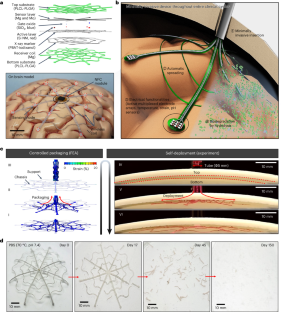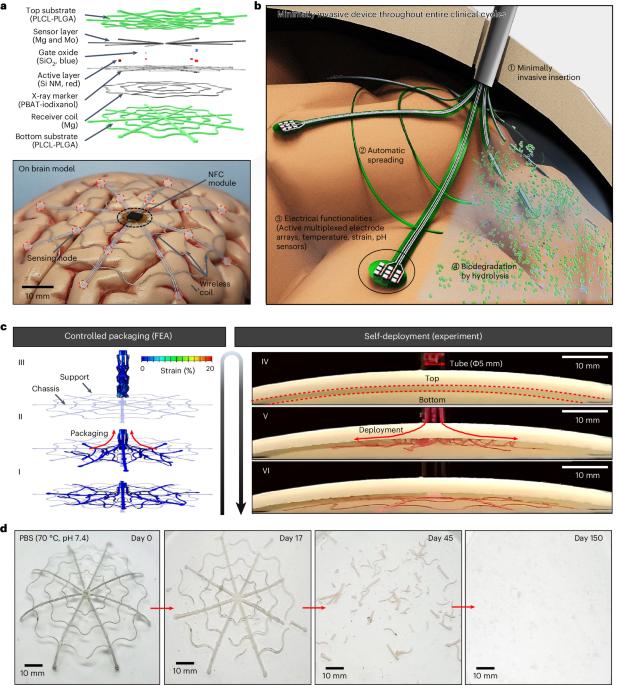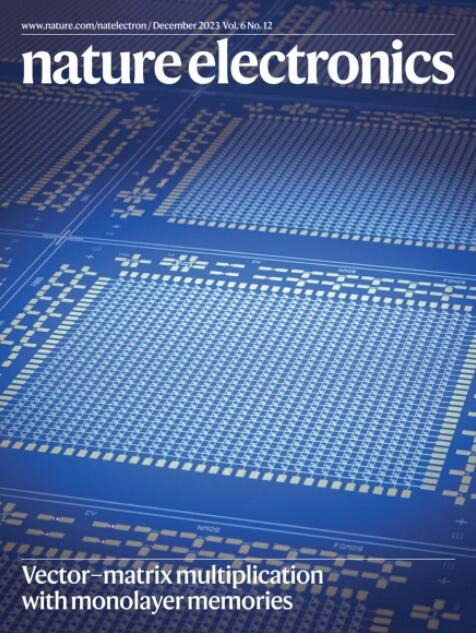用于连接大脑皮层的可生物降解、可自行部署的电子帐篷电极
IF 33.7
1区 工程技术
Q1 ENGINEERING, ELECTRICAL & ELECTRONIC
引用次数: 0
摘要
高密度、大面积电子界面是脑机接口技术的关键组成部分。然而,目前的设计通常需要患者接受侵入性手术,这可能会导致各种并发症。在此,我们报告了一种用于大脑皮层接口的可生物降解、可自行部署的帐篷电极。该系统可与多路复用阵列和无线模块集成,用于近场通信和数据传输。该系统可进行可编程包装,并可使用注射器通过小孔进行微创投放。投放后,它可以扩展到覆盖面积约为初始尺寸的 200 倍。电极在使用后还会在体内自然分解,最大程度地减少了后续移除手术的影响。通过体内演示,我们展示了我们的皮质界面平台可用于刺激大量皮质活动。本文章由计算机程序翻译,如有差异,请以英文原文为准。


A biodegradable and self-deployable electronic tent electrode for brain cortex interfacing
High-density, large-area electronic interfaces are a key component of brain–computer interface technologies. However, current designs typically require patients to undergo invasive procedures, which can lead to various complications. Here, we report a biodegradable and self-deployable tent electrode for brain cortex interfacing. The system can be integrated with multiplexing arrays and a wireless module for near-field communication and data transfer. It can be programmably packaged and self-deployed using a syringe for minimally invasive delivery through a small hole. Following delivery, it can expand to cover an area around 200 times its initial size. The electrode also naturally decomposes within the body after use, minimizing the impact of subsequent removal surgery. Through in vivo demonstrations, we show that our cortical-interfacing platform can be used to stimulate large populations of cortical activities. A biodegradable electronic tent electrode array that can be inserted into the brain cortex using a syringe, where it then expands to 200 times its original size, can be used for electrocorticography monitoring.
求助全文
通过发布文献求助,成功后即可免费获取论文全文。
去求助
来源期刊

Nature Electronics
Engineering-Electrical and Electronic Engineering
CiteScore
47.50
自引率
2.30%
发文量
159
期刊介绍:
Nature Electronics is a comprehensive journal that publishes both fundamental and applied research in the field of electronics. It encompasses a wide range of topics, including the study of new phenomena and devices, the design and construction of electronic circuits, and the practical applications of electronics. In addition, the journal explores the commercial and industrial aspects of electronics research.
The primary focus of Nature Electronics is on the development of technology and its potential impact on society. The journal incorporates the contributions of scientists, engineers, and industry professionals, offering a platform for their research findings. Moreover, Nature Electronics provides insightful commentary, thorough reviews, and analysis of the key issues that shape the field, as well as the technologies that are reshaping society.
Like all journals within the prestigious Nature brand, Nature Electronics upholds the highest standards of quality. It maintains a dedicated team of professional editors and follows a fair and rigorous peer-review process. The journal also ensures impeccable copy-editing and production, enabling swift publication. Additionally, Nature Electronics prides itself on its editorial independence, ensuring unbiased and impartial reporting.
In summary, Nature Electronics is a leading journal that publishes cutting-edge research in electronics. With its multidisciplinary approach and commitment to excellence, the journal serves as a valuable resource for scientists, engineers, and industry professionals seeking to stay at the forefront of advancements in the field.
 求助内容:
求助内容: 应助结果提醒方式:
应助结果提醒方式:


